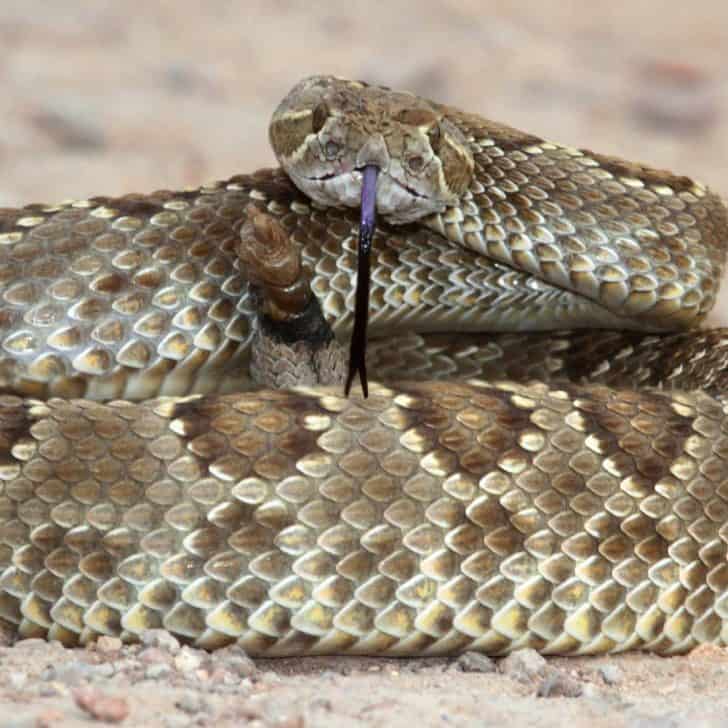There are several different varieties of venomous snakes in California. From legends of Old West lore like the Western Diamondback Snake to the dizzying dancers of the desert, the Sidewinder, there is great variety of poisonous snakes in California to enjoy (from a distance- of course!).
Not all poisonous snakes in California cause a life-threatening danger to humans. Some use their venom to subdue their prey and will only cause mild irritation to large mammals. Others are quite dangerous but not deadly, as long as medical treatment is sought immediately.
Only about 800 people receive a venomous snake bite in California per year. That”s just 2.5 bites per 100,000 people! And even better news- there are only one or two deadly rattlesnake bites per year in the entire country! Those are pretty great odds!
Snakes should not be feared but respected. Give them plenty of space and head their warnings (like a shake of the rattle) and you can enjoy these wonderful creatures who play a crucial role in our state’s ecosystems.
At the end of this article you will find snake safety tips as well as tips on what to do on the rare occassion of a venmous snake bite.
Want more California snake coverage? Here is your guide to 45 different types of snakes in Southern California.
Venomous Snakes in California
The Western Rattlesnake is the most widepspread venmous snake in California and there are four distinct subspecies that can be found in the state- The Northern Pacific Rattlesnake, Northern Mojave Rattlesnake, Southwestern Speckled Rattlesnake, and the Southern Pacific Rattlesnake. Here are details about each one:
1. Northern Pacific Rattlesnake
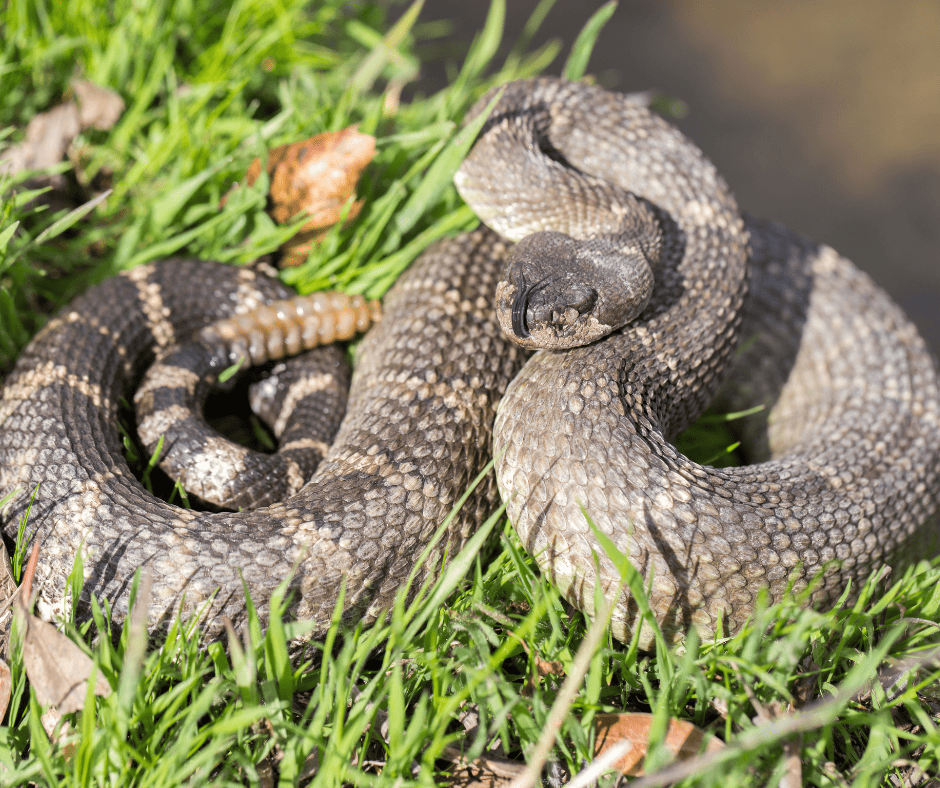
The Northern Pacific Rattlesnake is a larger snake, with adults typically ranging from 3 to 4 feet in length. They have a relatively thick body with a series of dark, diamond-shaped blotches running down their back. The coloration can vary, but they often have a brown, gray, or olive background color, with darker brown or black blotches bordered by lighter scales.
This subspecies is found in the Pacific Northwest, including parts of Oregon, Washington, and Northern California. Northern Pacific Rattlesnakes can be found in a variety of habitats, including grasslands, woodlands, rocky slopes, and desert areas. In California, they are known to inhabit regions such as the Sierra Nevada, the coastal ranges, and the Central Valley.
Northern Pacific Rattlesnakes are primarily active during the warmer months and are most active during the early morning and late afternoon. They are ambush predators, feeding on a diet that primarily consists of small mammals, birds, lizards, and occasionally other snakes. They use their venom to immobilize and digest their prey.
Fun fact: A new rattle is gained each time a rattlesnake sheds it skin!
2. Northern Mojave Rattlesnake

The Northern Mojave Rattlesnake, aka: the Mojave Green Rattlesnake, is found in southeastern California, from the Colorado River north of the San Bernardino County line, west through the Mojave Desert to the Antelope Valley, to Walker Pass in the Sierra Nevada, and east of the Sierra Nevada into Inyo County.
In many ways, the Northern Mojave Rattlesnake looks and acts like a Western Diamondback, but there are some differences in appearance.
The most easy way to differientiate the two is location, location, location. Northern Mojave Rattlesnakes live in the high desert while Western Diamondbacks live in Southern California’s low desert.
It is a stout snake with a triangular head and a blackish or brown body with a series of light-colored saddles. The tail is long and has a prominent rattle. Adults typically measure between 2 and 4 feet in length.
This snake prefers open, arid habitats, such as grassland, desert scrub, rocky slopes, creosote bush flats, open juniper woodland, and light chaparral. It can also be found in lower mountain slopes up to about 8,000 feet in elevation. This rattlesnake feeds primarily on small mammals (mice, rats, rabbits, gophers), but will eat lizards and amphibians as well.
The Northern Mojave Rattlesnake is the most venomous snake in California, and its bite can be fatal if not treated promptly. However, most bites are not fatal, and with proper medical care, the vast majority of people bitten by this snake make a full recovery.
3. Southwestern Speckled Rattlesnake

The Southwestern Speckled Rattlesnake is found in the southwestern United States, including parts of Arizona, New Mexico, and Southern California. It has a light brown or grayish-brown coloration with lighter blotches outlined by darker speckles.
It lives in the Santa Ana mountains of eastern Orange County, most of San Diego County (except the coastal area), eastern Imperial County, most of Riverside County, most of the southern half of San Bernardino County, and the Antelope Valley.
Speckled Rattlesnakes are most often spotted in rocky areas and they come in a variety of colors that camouflage well with their rocky homes. When the rocks are lighter in color, the snake will be snake will be light in color with darker speckled bandings across its back. If the rocks are darker, the snakes will be dark as well.
Adult Speckled Rattlesnakes are typically 2-3.5 feet in length. They do have black and white rings near the end of their tail at the rattle. Like all pit vipers, they have pits on the sides of their triangular heads which they use to detect heat and identify prey. They are primarily ambush predators who eat small mammals, reptiles, and small birds.
Learn more about Southern California wildlife. Here is your guide to all the hawks in Southern California.
4. Southern Pacific Rattlesnake

The Southern Pacific Rattlesnake is the subspecies of Western Rattlesnake that is most commonly seen in Southern California. They live in Southern California west of the San Bernardino Mountain range. They won’t be found in the desert or Imperial County.
Many people tend to think that the rattlesnakes they are seeing in the LA/OC/SD area are Western Diamondback Rattlesnakes, but those snakes do not live in this area. If you see a rattler in this region, it is very likely a Southern Pacific Rattlesnake.
You will see them most often in chaparral, rocky areas, and grassy areas. I have seen them most often near rocks sunning themselves or in dry grass near the edges of trails.
Southern Pacific Rattlesnakes are most active in the spring and fall. Truth be told, they usually see you before you see them and will give you fair warning with a rattle of their tale. They are not aggressive but they are venomous, so steer clear and give them plenty of space if you are passing by.
These snakes are anywhere from 1-5 feet long, and have a stripe behind the eye extending behind the corner of the mouth. Southern Pacific Rattlesnakes have rattles and their tails are more stumpy than a Gopher Snake (which can look similar). Gopher Snakes have tails that taper and become quite skinny at the end and no rattle.
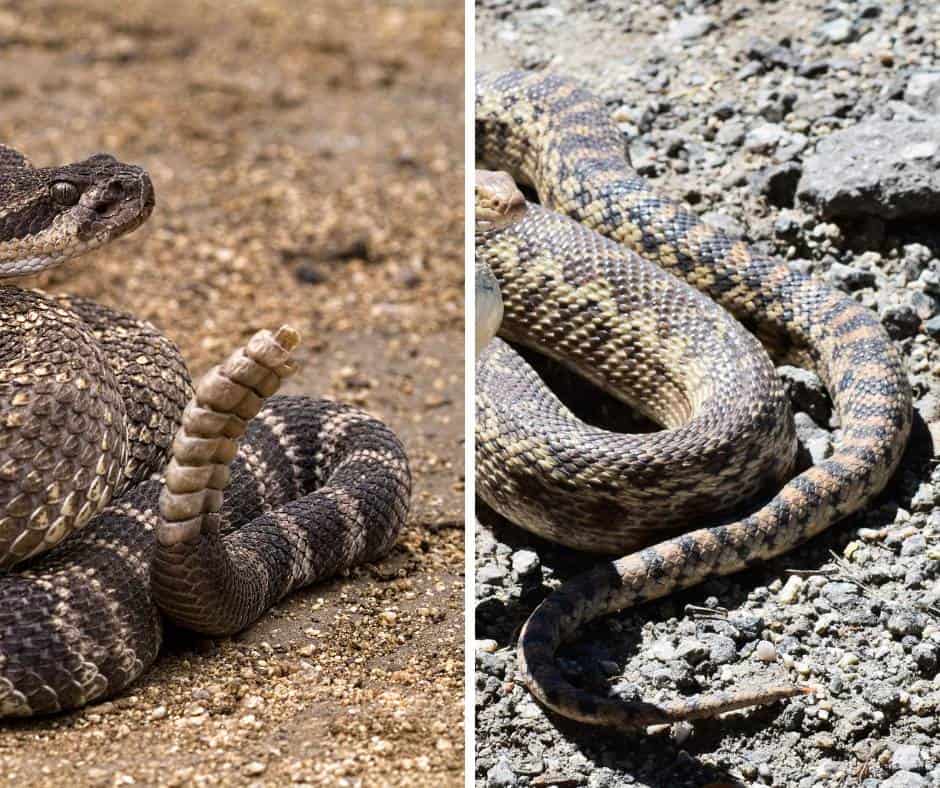
They do have light and dark rings at the tail but they aren’t sharply contrasting like the Western Diamondback and Northern Mojave Rattlesnake. There is a thicker tail ring right before the rattle that is generally dark brown in color. It has a light brown or grayish-brown coloration with distinctive dark blotches along the body.
Like other rattlesnakes in California, these snakes eat lizards, small mammals, amphibians, birds, and even other snakes!
There are over 25 varieties of snakes in Joshua Tree National Park, including the Southern Pacific Rattlesnake. Use our Joshua Tree Day Trip Itinerary and keep your eyes out while exploring.
5. Western Diamondback Rattlesnake

The Western Diamondback Rattlesnake is a beautiful rattlesnake that is highly regarded in Western lore. It is named for the diamond-shaped pattern on its back, which consists of dark brown or gray-brown diamond-shaped blotches outlined in lighter color.
They have a triangular-shaped head and a distinctive rattle at the end of their tail, which they use as a warning signal when threatened. These are big snakes, generally 3-5 feet in length, but some have been recorded at up to seven feet long! The Western Diamondback Rattlesnake is the largest rattlesnake in California.
Western Diamondbacks are not agressive towards humans and most bites occur when people are messing with these snakes or not paying attention to where they are walking. They can strike within one-third of their body length, so give them space!
Diamondbacks have pits on the side of their heads that sense heat and help them target prey. They eat a variety of small mammals such as mice, kangaroo rats, and jackrabbits.
Did you know? Rattlesnake rattles are made of keratin, which is the same protein that makes up our fingernails and a rhino’s horn. Pieces of rattles can get damaged or break off, but it is painless.
6. Red Diamond Rattlesnake
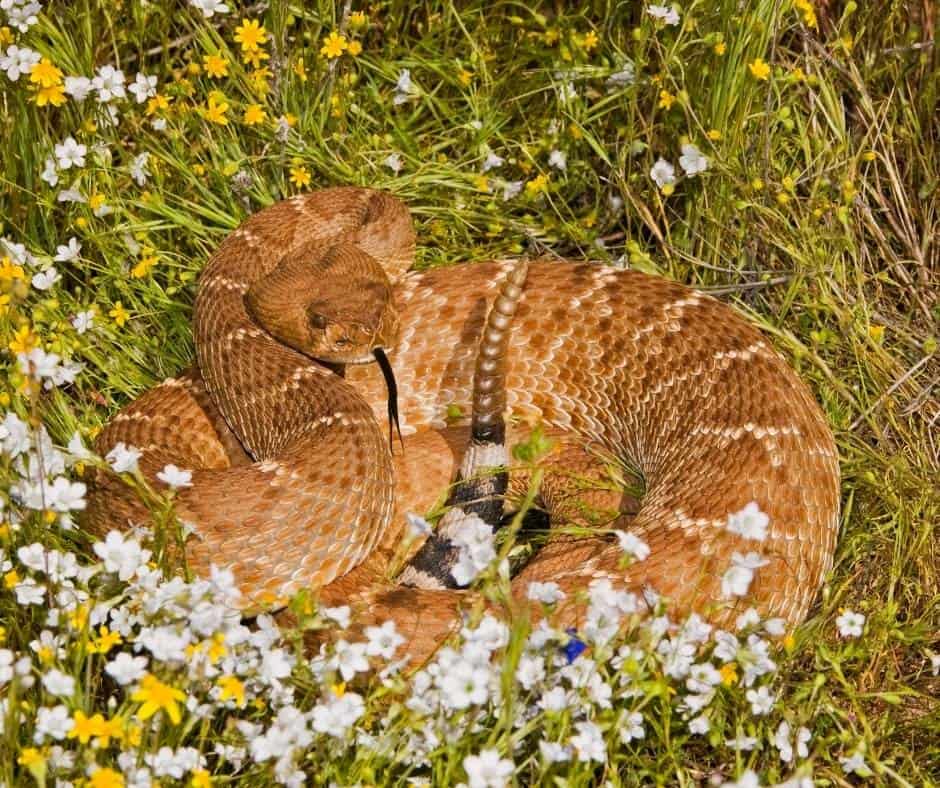
The Red Diamond Rattlesnake is another one of the beautiful venomous snakes in California. It lives in the southernmost reaches of the state, mostly in coastal areas, chaparral, and rocky, scrubby mountain areas in San Diego County, Orange County, and western Riverside County.
It is easiest to identify this snake because of its rusty or ruddy red coloring. The snake’s body does have a faint diamond pattern and the black and white rings near the rattle that are common among many rattlesnakes in Southern California.
The Red Diamond Rattlesnake is 2-5 feet long and has those trademark rattlesnake pits on the sides of their triangular heads used to detect heat and identify prey. They eat small mammals, lizards, and birds .
Fun fact: A rattlesnake shakes its rattle 60 time per second. That’s fast!
7. Mojave Desert Sidewinder
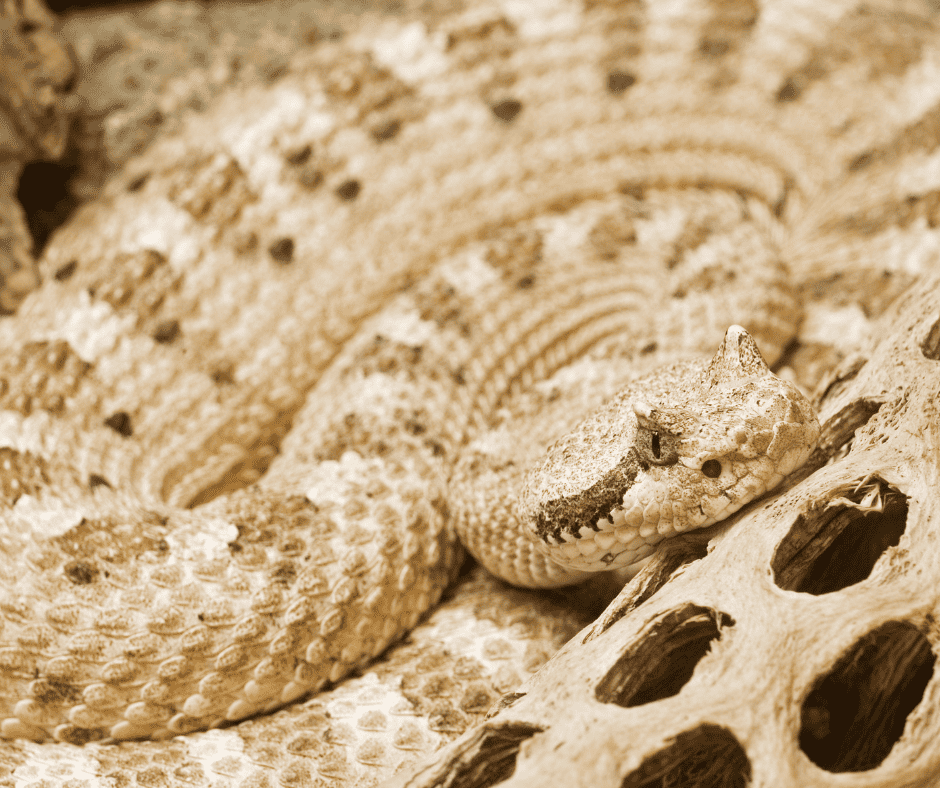
The Mojave Desert Sidewinder or Horned Rattlesnake, is a venomous snake species found primarily in the Mojave Desert in California. Their venom is not considered highly dangerous to humans, and bites are relatively rare. However, if you are bitten, you should still definitely seek medical attention.
The Mojave Desert Sidewinder has a distinctive horn-like projection above each eye, which gives it a unique appearance. The body coloration varies but often includes shades of tan, brown, or gray, allowing the snake to blend in with its desert surroundings and is typically 2-3 feet long.
One of the most remarkable adaptations of sidewinders is their unique mode of locomotion known as sidewinding. Rather than slithering in a typical serpentine fashion, the sidewinder moves by utilizing a lateral series of sideways loops, with only a few points of its body in contact with the ground at any given time. This specialized movement helps the snake navigate loose sandy terrain efficiently.
Sidewinders are pit vipers and use their heat-sensitive pits located between its nostrils and eyes to detect and accurately locate warm-blooded prey, such as small mammals, even in complete darkness or buried beneath the sand. Sidewinders are primarily nocturnal, being most active during the cooler hours of the evening and night.
8. Colorado Desert Sidewinder
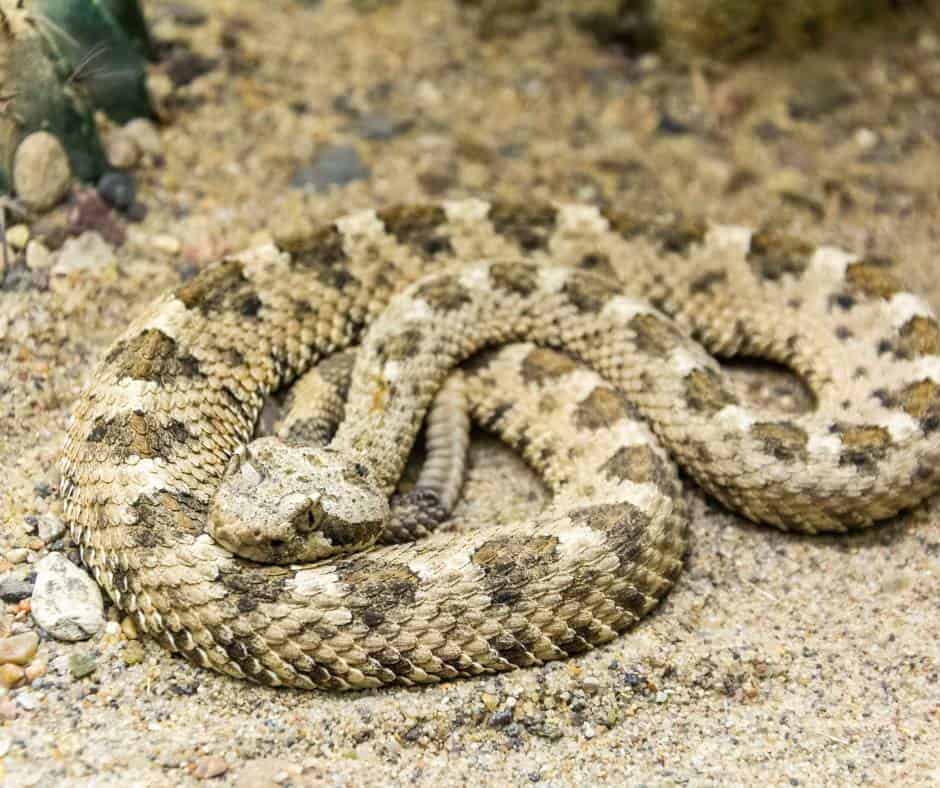
The Colorado Desert Sidewinder is a sidewinder subspecies that is primarily found in the Colorado Desert of California which is in Riverside and Imperial County.
Sidewinders have a distinctive appearance with a relatively small and slender body, typically measuring 1.5 to 2.5 feet in length. They have light tan to pale brown coloration, often with darker brown or reddish-brown patches or crossbands on their back. Their most notable features are the horn-like scales above each eye.
Colorado Sidewinders are well-adapted to desert environments. Their name comes from their unique method of locomotion, where they move by a sidewinding motion. This movement pattern helps them navigate loose sand while minimizing body contact with the hot surface. Their scales are also specialized to enhance traction in sandy environments.
Sidewinders are primarily nocturnal, preferring to be active during the cooler hours of the evening and night. They spend much of their time buried in the sand during the day, seeking refuge from the intense desert heat.
9. Panamint Rattlesnake

The Panamint Rattlesnake is a rattlesnake found in the Panamint Mountains of Death Valley National Park. It lives on rocky slopes as well as the canyons and shrublands of this arid desert range.
This rattlesnake has a slender body with a distinct diamond-shaped pattern along the back. The coloration of the snake varies, but it typically has a gray or brownish background color with dark brown or black blotches bordered by lighter edges. Adults are usually 3 to 4 feet in length.
Like all rattlesnakes, the Panamint Rattlesnake has a rattle at the end of its tail which is used to give a warning as a mechanism of defense. They are primarily nocturnal and secretive, spending much of their time hidden under rocks or in crevices during the day. These ambush predators feed on small mammals, lizards, birds, and even other snakes.
The Panamint Rattlesnake is considered a species of conservation concern due to its restricted range and habitat fragmentation. It is protected under California state law, and efforts are being made to conserve its habitat and monitor its populations.
10. Lyresnake
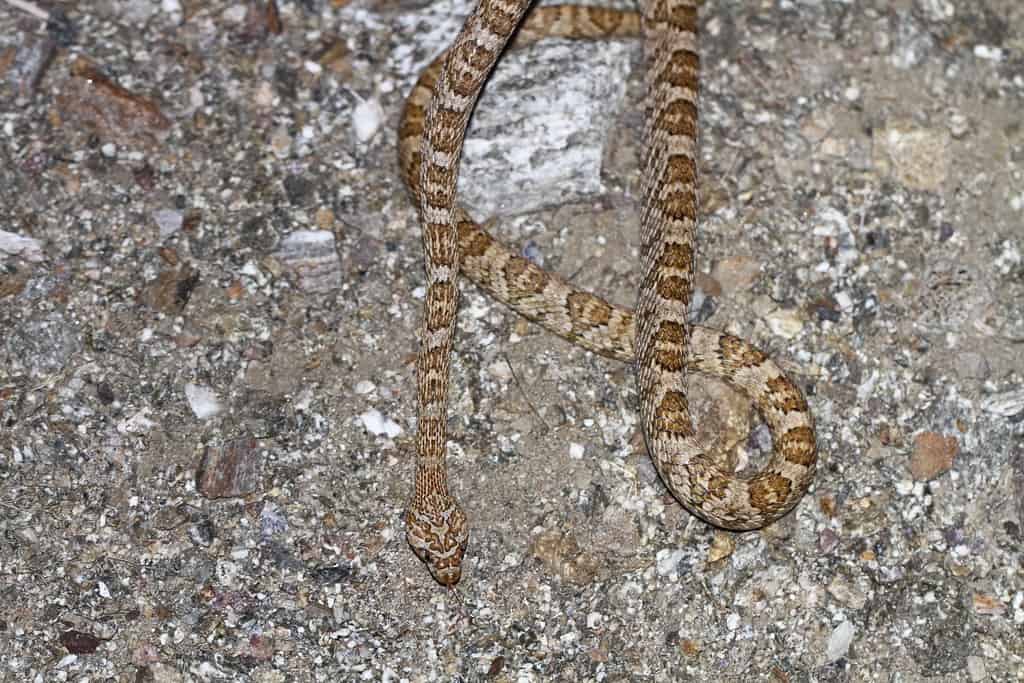
The Lyre Snake is a variety of venomous snake that lives in California. Thankfully, the venom of this snake is not nearly as dangerous of those previously listed in the this guide. It may cause some irritation to humans and large animals, but isn’t truly dangerous.
There are two species of Lyre Snake that call California home. The California Lyre Snake is by far the most common. It lives throughout much of Southern California, other than the desert regions west of the LA Metro area and most of Imperial County. The other variety is the Sonoran Lyre Snake which lives in far eastern San Bernadino, Riverside, and Imperial counties.
These snakes generally live in rocky areas like deserts and chaparral hillsides. They are good at climbing in and around rocks and their coloration makes for excellent camouflage.
The color of these snakes’ bodies (which are 2-3 feet in length) usually matches the rocks of their habitat, which are usually shades of tan or brown. They have large, irregular shaped splotches on their backs and smaller version of those splotches on their sides. The splotches are darker than the body. The Sonoran Lyre Snake has fewer splotches than California Lyre Snake and their splotches tend to be further spaced apart.
They have a v-shaped marking on the top of their heads, aka: a lyre and the pupils of the Lyre Snake are vertical.
Lyre Snakes are nocturnal and mostly eat lizards, but they will also eat small snakes and mammals. They will also eat birds and bats. The tend to camouflage themselves in the rock and sneak up and ambush their prey.
11. Ring-necked Snake
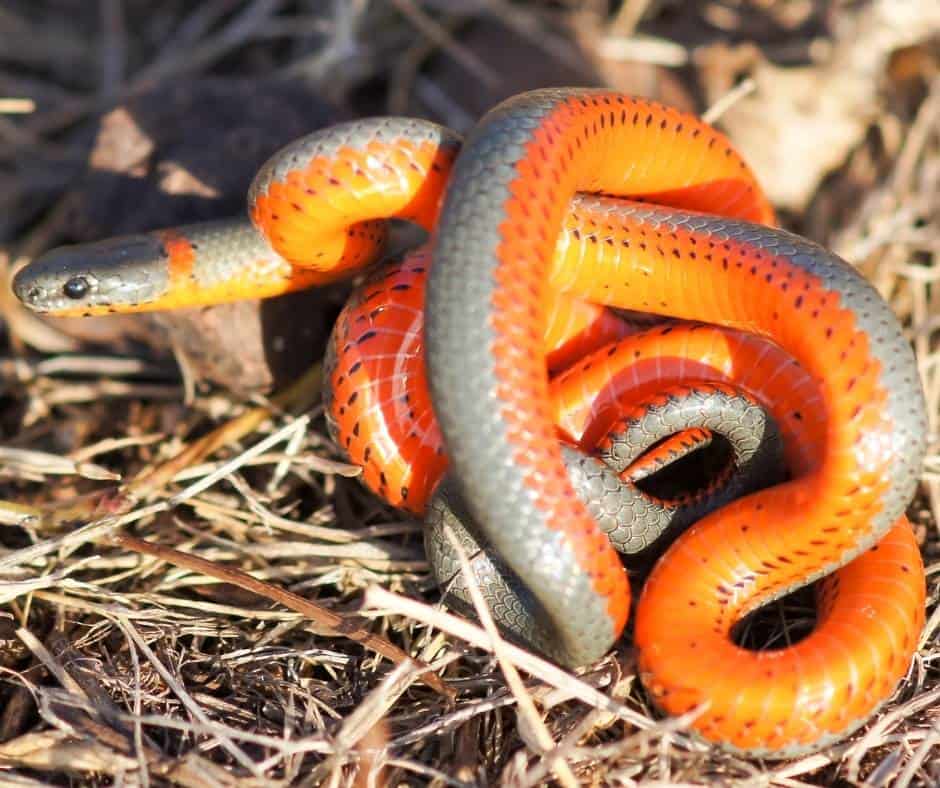
The Ring-necked Snake is mildly venomous, but the good new is that the venom does not pose a threat to humans. In the rare event of a bite from a Ring-necked snake, it may cause a slight irritation or localized reaction, but it is generally harmless and does not require medical attention.
They tend to be shades of gray, from olive to charcoal, and have a distinctive orange or yellow band on the back of their necks. They are bright orange underneath, and will flip their tail up to show you their underside if they feel threatened.
There are four subspecies of Ring-necked Snake in California:
The Monterey Ring-necked Snake lives in Santa Barbara County and up the Central Coast.
The San Bernardino Ring-necked Snake can be found in the LA Metro area (minus the Antelope Valley) frmo Ventura County south to Orange County.
The San Diego Ring-necked Snake lives in San Diego County.
The Sierra Ring-necked Snake lives in montane habitats within the Sierra Nevadas, including forests, meadows, and rocky areas.
Ring-necked Snakes are small, only about pencil width, and just 10-16 inches in length. They live in moist habitats like woodlands, irrigated farmland, grasslands, riparain areas, or rocky hillsides. These are shy snakes that generally hide under things and you are most likely to find them by lifting up rocks or logs, or out around dusk.
They like to eat amphibians like salamanders, small frogs, and tadpoles. They will also eat slugs, worms, and tiny snakes and lizards.
12. Nightsnake

Nightsnakes are another species of snake that is mildly venomous, but the venom is not dangerous to humans. The snake’s venom is primarily used for subduing its small prey, and typically result in only mild symptoms such as slight pain and localized swelling on humans.
There are three subspecies of the Nightsnake in California:
The California Nightsnake lives along the Central Coast, Sierra Nevada Foothills, and the mountains north and west of the Sacramento Valley,
The Desert Nightsnake is in Mojave and Colorado river regions of the state as well as the arid regions in the far northeastern corner of the state.
The San Diego Nightsnake lives mainly in Ventura County, LA Metro, and San Diego Metro regions that aren’t desert.
These snakes are common to chaparral and deserts, grasslands and sagebrush, and even backyards! They like to hide under rocks or pieces of wood during the day. At night they hunt for lizards, frogs, salamanders, and small mice. They inject their mild venom by chewing.
Nightsnakes can look like rattlesnake, but they are much smaller (10-16 inches), don’t have rattles, and are nocturnal. They also have flat, triangular heads. Nightsnakes can also be mistaken for Gopher Snakes but again, they are much smaller. Also they have vertical pupils whereas the Gopher Snake has round pupils.
Their base color tends to match their environment which is usually anywhere for cream to light brown or gray. They have big brown or gray splotches down their backs and small splotches on their sides. They have bigger, darker blotches on their necks and their heads that match their base color.
Tips on How to Minimize Your Risk of Snake Bites While Exploring California

I love to hike and explore the more wild portion of our state, but encounters with wildlife are inevitable. I have seen rattlesnakes while hiking many times but have never come close to a bite because I follow some common sense tips. Here they are:
- Wear appropriate footwear: When hiking or exploring in snake-prone areas, especially during the spring and fall when they are most active, wear closed-toe shoes or boots to protect your feet and ankles. This is the place you are most likely to get bit, especially if you accidentally step on a snake.
- Stay on designated paths: Avoid walking through tall grass, dense vegetation, or rocky areas where snakes may be hiding.
- Watch where you are going: We call my daughter the “snake finder” because she always has her eyes on the ground ahead of her on the trail. She has saved more than one oblivious hiker from an unnecessary encounter.
- Avoid reaching into concealed areas: I feel like this should go without saying but I will say it- don’t stick your hands into holes in the ground or piles of rocks where snakes might be resting. If you want to lift a log or rock, use a tool or stick to gently probe before lifting it up.
- Avoid surprising snakes: Make noise while walking, especially in areas with limited visibility, to alert snakes of your presence and give them a chance to move away.
- Use a flashlight at night: If you’re exploring at night, use a flashlight or headlamp to illuminate your surroundings and watch for any snake movement. Many snakes are nocturnal.
- Keep a safe distance if you see a snake: If you encounter a snake, give it a wide berth and maintain a safe distance. Most snakes will try to retreat and avoid confrontation if they feel threatened. And for goodness snake, don’t try to touch or pick up the snake!
If You Get Bit by a Venomous Snake in California
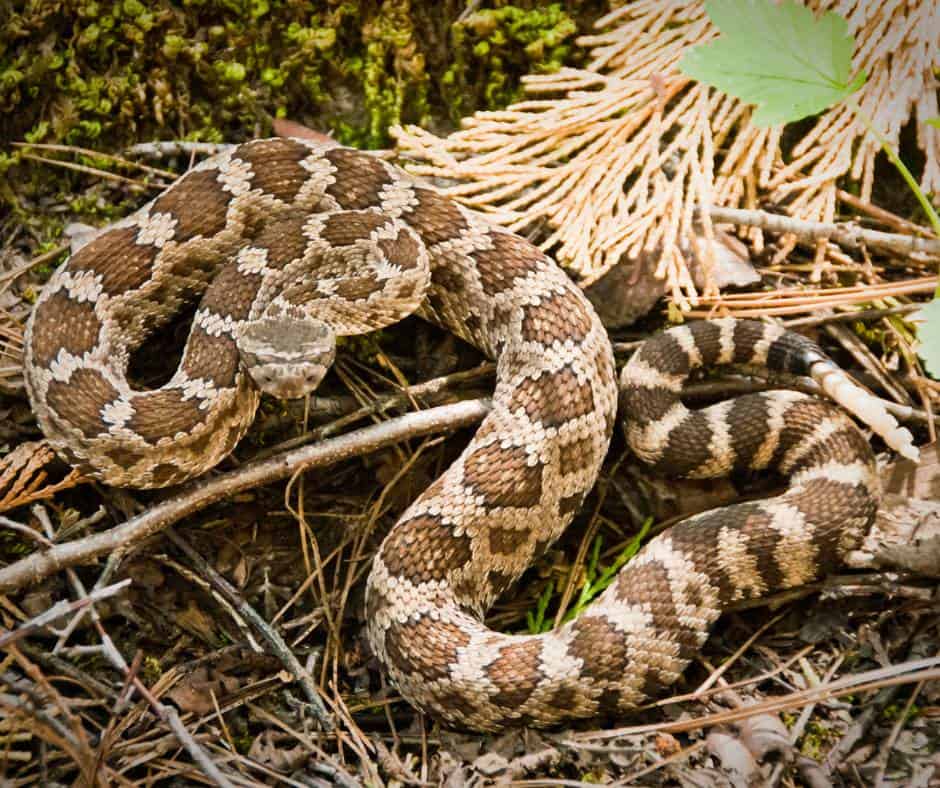
If you get bitten by a rattlesnake, it is important to seek medical attention immediately. Follow these tips and try to get to a hospital as soon as possible:
- Stay Calm: Keep the affected area as still as possible. Movement can spread the venom more quickly through the body.
- Call for help: Call 911 or have someone call for help immediately. Describe the situation and let them know that it is a snakebite.
- Remove tight clothing or jewelry near the bite: Swelling may occur, and it’s important to prevent constriction if possible.
- Keep the bite below heart level: If possible, position the affected limb below the level of your heart to slow the spread of venom. This can help reduce the rate at which venom circulates through the body.
- Do not apply a tourniquet: A tourniquet can worsen tissue damage and restrict blood flow, potentially causing further harm.
- Do not ice the wound: Cold applications are generally not recommended as they can worsen tissue damage.
- Do not attempt to suck out the venom: You have probably seen this happen in Old Westerns but it isn’t a good idea. It is ineffective and can introduce bacteria into the wound.
:

